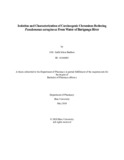Isolation and characterization of carcinogenic chromium reducing Pseudomonas aeruginosa from water of Buriganga river

View/Open
Date
2019-05Publisher
Brac UniversityAuthor
Badhon, S.M. Saiful IslamMetadata
Show full item recordAbstract
Hexavalent chromium is a highly toxic heavy metals which has the carcinogenic and mutagenic
property. It is mobile in nature and causes many more diseases such as skin cancer, lung cancer,
nasal infection etc. This hexavalent chromium is mainly used in diffrent industries like leather,
tannery, dye, stainless steel etc. From these industries, chromium released in the environment
without proper treatment which can be a dangerous for human and the environment. Hexavalent
is more toxic than any other form of chromium.In this study, a bacterial strain was indentified
named Pseudomonas aeruginosa which has the capability to reduce hexavalent chromium and
produce trivalent form and show the resistance to Chromium. The strain was collected from
Buriganga river and isolation was done in nutrient agar plates. Then purified the strain and used
in different experiment such as DPCZ based bioassay. Bioassay method was used to find out
their reduction capacity at three different temperature 25˚C, 37˚C, and 42˚C with three
diffrentpH 5.5, 7, 8.5. From bioassay study, it was observed that the isolate has good Chromium
reduction capacity at 37˚C pH 8.5 and 7. Highest reduction was found at 37˚C pH 8.5 which
means the optimum reduction condition of the strain. It is also found from this study that the
enzyme that bacteria used for reduction is exoenzyme. From this study it was also observed that
this strain is mostly susceptible to Ciprofloxacin whereas strain is resistant to some other
antibiotics such as Penicillin G, Amoxycillin, and Cefuroxime Sodium. MIC was also observed
which showed that bacteria can tolerate upto 9mM of chromium concentration. Finally 16S
rDNA squencing was used for identification and using the sequence data a phylogenetic tree was
made which showed the similarity between the experimental strain and Pseudomonas
aeruginosa.
